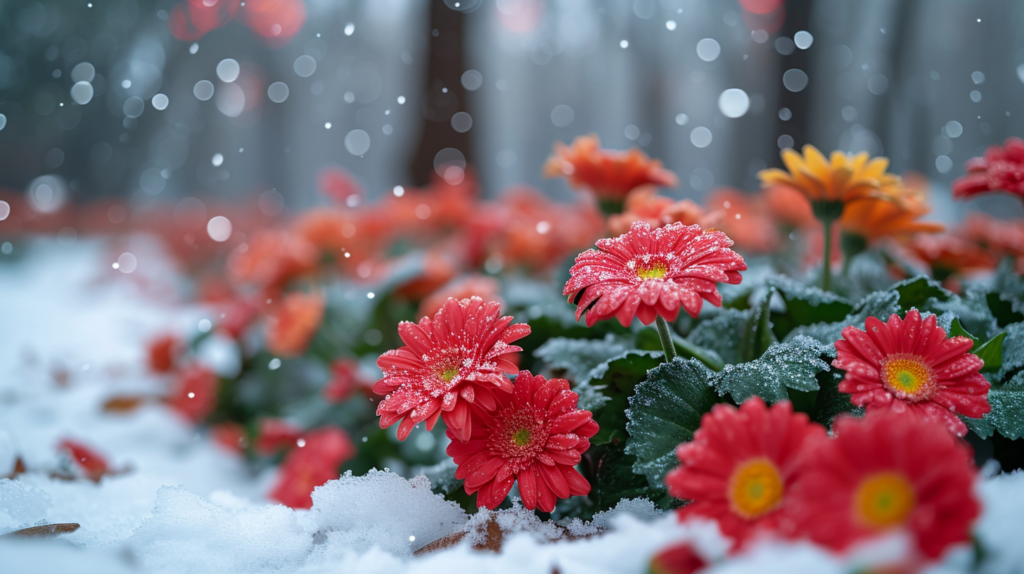Crisp, cold weather signals lawns to go dormant for winter. But even while grass is not actively growing, it still needs moisture. Providing proper winter watering protects the crown and root system so your lawn can revive green and healthy in spring. Understanding winter watering guidelines will keep your grass hydrated through harsh, dry conditions.

How Dormant Grass Loses Moisture
Several factors cause lawns to lose moisture over winter:
- Frozen soil prevents water penetration to roots, which continue respiring moisture.
- Desiccating winds whip moisture from exposed grass blades and thatch.
- Alternating freeze and thaw cycles draw moisture to the surface then evaporate it.
- Low humidity combined with dry winds desiccate grass plants.
- Direct sun shining on frozen or dry soil causes moisture evaporation.
While top growth is dormant, the crown and roots must stay hydrated at a minimal level to survive.
Signs Your Lawn Needs Winter Water
Watch for these signals that your lawn is too dry over winter:
- Twisting, folded, browned grass blades when you sweep aside snow. This indicates desiccation.
- Footprints remaining compressed in the lawn for extended periods. Moist soil quickly rebounds.
- Crunchy, frozen feeling soil when you step on it. Properly hydrated soil remains pliable.
- Grass pulling loosely from the ground. Well-hydrated crowns are firmly anchored.
- Grayish-white or browned grass color instead of yellow-green.
- Snow melting unusually fast. Dry soil and grass readily absorb meltwater.
Take notice and respond promptly if these red flags occur.
How to Water Under Cold Conditions
Watering dormant grass requires some adjustments:
- Monitor soil moisture weekly by digging down several inches. Water if the top few inches become dry and crumbly.
- Use sprinklers temporarily to mimic a soaking rain. Move sprinklers frequently to avoid runoff.
- Adjust timers for brief, frequent watering cycles. This prevents ice sheets from forming on grass blades.
- Water during warmer daytime periods above 40 degrees F when possible. Avoid applying moisture onto frozen ground.
- Prevent sidewalks or paved areas from becoming slippery ice rinks. Adjust sprinkler coverage accordingly.
- Consider a lawn winterizing anti-desiccant spray that coats grass to retain moisture if conditions are very harsh and dry.
Proper winter watering techniques keep lawns hydrated without causing excess ice buildup.
How Much to Water in Winter
Overwatering dormant lawns is just as detrimental as under-watering:
- Total winter watering only needs to deliver 10-20% of summer volumes. Excess moisture damages dormant roots.
- Apply just 1/4 to 1/2 inches per week from rain or watering. This light watering moisturizes soil without saturating it.
- Let soil dry between watering. Wait until the top few inches become somewhat dry before reapplying moisture.
- Reduce frequency compared to summer, watering every 2-4 weeks depending on precipitation and your climate conditions.
- Avoid frequent, heavy watering that keeps soil continually soggy. Standing water leads to fungal issues.
With proper hydration, your lawn will stay healthy through cold snaps, wind, and freeze-thaw cycles. Monitor soil weekly and provide light moisture when the top layer dries out. Aim for deep, periodic soakings all winter long.
Special Winter Watering Situations
Certain cases call for modified winter watering:
New sod – Water new sod installations more frequently, up to twice weekly, providing 1/2-3/4 inches per session. Young sod roots need ample moisture to establish.
New seed – Ensure good contact between lightly watered topsoil and grass seeds to trigger germination. Keep seeds moist until sprouted.
Sloped areas – Apply 20% more water to sloped areas to counteract runoff and penetration issues. Water until runoff starts, let soak in, then restart watering.
Drainage problems – Improve drainage through aeration and grading before winter. Redirect downspouts and drain pooled water to keep moisture even.
Salt damage – To combat salt buildup from deicers, make sure soil is moist before expected snow or ice. Water again after to leach salts downwards.
Adjusting your winter watering practices according to weather and your lawn’s needs will keep grass in top shape season after season.
Frequently Asked Questions About Winter Lawn Watering
Q: How do I know if my lawn needs water during winter?
A: Check soil moisture weekly by digging down a few inches. If the top couple inches become dry and crumbly or you see footprints lingering, it’s time to water. Also watch for greyish winter grass color and folded, twisting blades as signals to water.
Q: What temperature should it be to water grass in winter?
A: The ideal time is during daytime highs above 40 degrees Fahrenheit so water can penetrate soil and evaporate rather than freezing immediately. Watering on warmer winter days is absorbed better.
Q: How often should I run my sprinkler system in winter?
A: Water dormant grass about every 2-4 weeks depending on your climate, more often if conditions are windy and dry. Adjust timers for 3-5 minute cycles to wet soil without oversaturating it. Drain and winterize irrigation systems after final winter watering.
Q: Does lawn fertilizing continue over winter?
A: Avoid winter fertilizing, which leads to tender new growth prone to cold damage. Instead, do a final light feeding in late fall as grass goes dormant. Resume fertilizing in early spring just as grass greens up and begins regrowth.
Q: Should I continue mowing my lawn in winter?
A: Only mow if grass resumes active growth during periodic winter warm spells and needs cutting. Otherwise, stop mowing once grass goes dormant. Never cut shorter than 2-3 inches or 1/3 of blade length even in winter.
Q: When is the best time to aerate and dethatch cool season lawns?
A: The optimal time is early fall when grass is still actively growing enough to recover before winter dormancy. Dethatch if thatch exceeds 1/2 inch deep. Core aerate every 2-3 years to improve penetration of air, water and nutrients.
